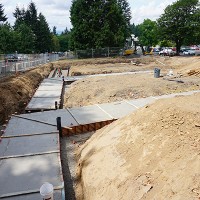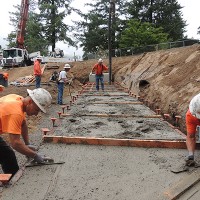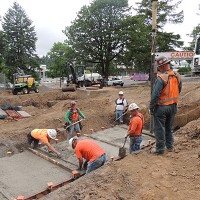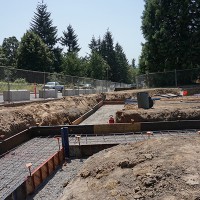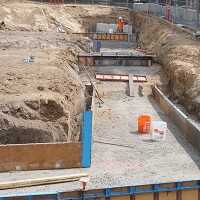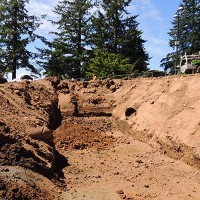This content was published: August 6, 2015. Phone numbers, email addresses, and other information may have changed.
New stormwater detention pond takes shape at Sylvania
Photos and story by Katherine Miller
Aug. 6, 2015
Portland Community College this summer is constructing a stormwater detention pond at the south end of Sylvania’s Parking Lot 5, part of the campus improvements funded by the 2008 voter-approved bond measure and a project that has long been of interest to adjacent residents.
Sylvania – largest of Portland Community College’s four campuses – has more than 53 acres of impervious surface, which creates an average of 44 million gallons of stormwater runoff annually, according to the City of Portland’s Bureau of Environmental Services.
That runoff from parking lots, streets, buildings and walkways flows to Ball Creek, then to Fanno Creek, and finally to the Tualatin River. Runoff that isn’t properly managed can wash pollution into rivers and streams, destroy habitat, and cause flooding and stream bank erosion, says the bureau.
When the new detention pond is completed in September, it will consist of a series of terraced basins designed to capture stormwater as it flows downhill and lower the rate at which it is released into the outfall, thereby decreasing the potential for downstream flooding and erosion.
In addition to controlling the water’s flow, the detention pond will improve its quality. The U.S. Environmental Protection Agency (EPA) explains that a detention pond’s [pdf] “natural physical, biological, and chemical processes” work to remove pollutants in the runoff. “Sedimentation processes remove particulates, organic matter, and metals, while dissolved metals and nutrients are removed through biological uptake.”
Although the college has built many stormwater management projects in the course of campus improvements, the detention pond goes above and beyond what has been required by building code and is an investment aligned with PCC’s commitment to sustainability and environmental stewardship.
Here’s an overview of some of the projects that have been completed at Sylvania in recent years and a brief description of the types of systems:
Rain gardens: Sylvania has two, one near the Campus Services Building and the other west of the Learning Garden near Parking Lot 14. A rain garden is typically a smaller system than a detention pond and does not need to be engineered. It uses a naturalized basin landscaped with native plants to collect stormwater and infiltrate sediment and pollutants.
Bioswales: Sylvania’s bioswales are located along the new segment of G Street across from Health Technology, and at the parking permit station on G Street near Parking Lot 9. Bioswales are similar to rain gardens in that they are vegetated landscape depressions designed to capture, treat and infiltrate stormwater; the major difference between the two systems is that bioswales are often intended to move water from one area to another, such as a rain garden, watershed or storm sewer.
Flow-through planters: There are flow-through planters located at the kiln yard next the Communication Technology Building, and as well as the storage building next to the Automotive and Metals Building. The planters are structures or containers often placed on impervious surfaces, such as the concrete next to buildings; they capture stormwater, which slowly infiltrates down through the soil, collects in a perforated pipe and drains to a destination point or conveyance system.
Manhole and water treatment device: An 8-foot-wide, 25-foot-deep manhole and water treatment device was installed south of G Street across from the Heat Plant building. Storm water flows through this manhole and is further detained and treated prior to being released at an outflow.
Detention pipes: These are located on the south sides of the Technology Classroom and Campus Services buildings. The culvert-sized pipes store stormwater and slowly release it into the water treatment system described above.
Read more about the many types of stormwater management systems in this detailed article.
PCC’S 2008 voter-approved $374 million bond program is increasing opportunities for residents to access quality, affordable higher education close to where they live and work. Additional classrooms, updated equipment and technology, and advanced workforce training programs are helping to pave the way for future employment options. For more information, visit the bond website.

